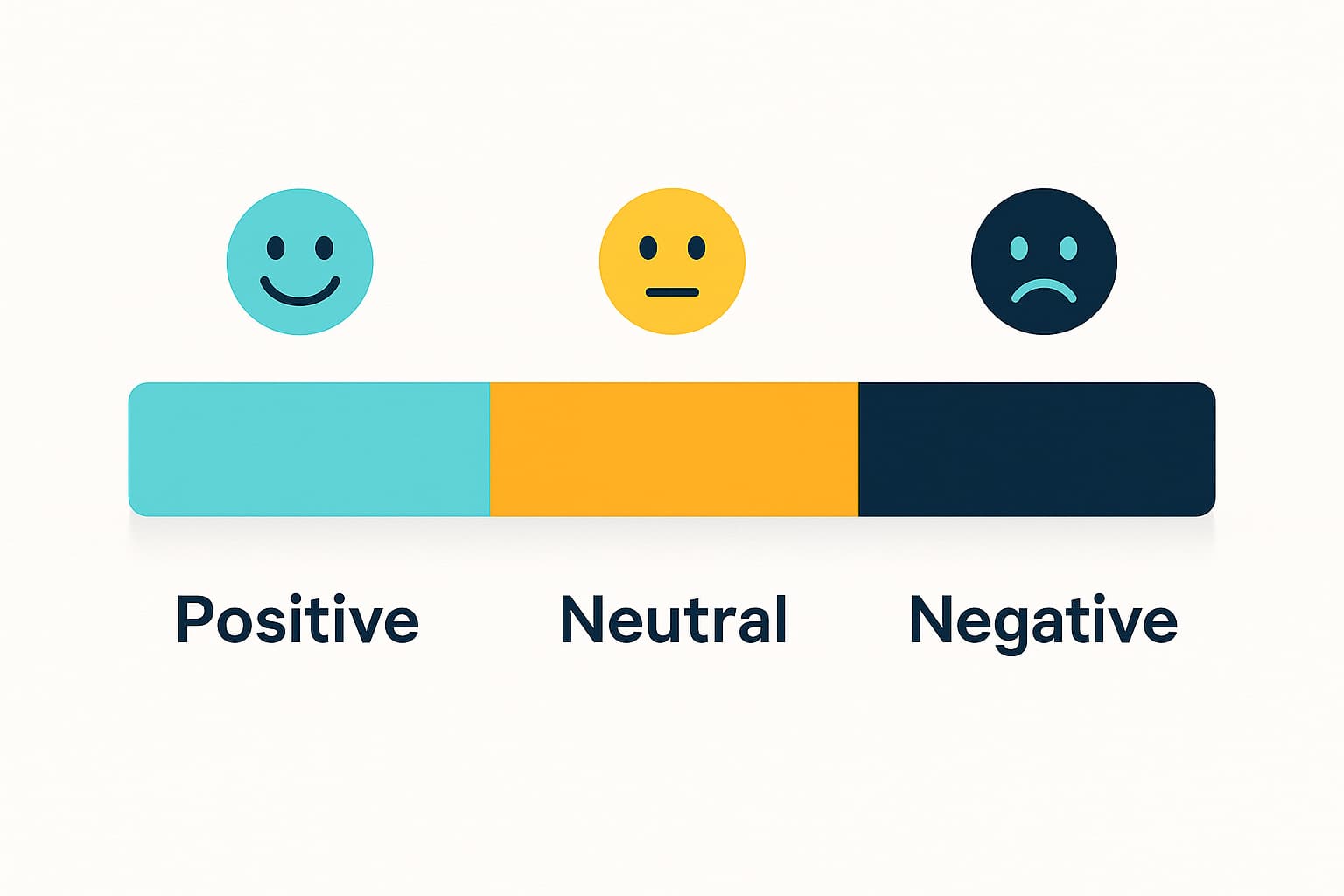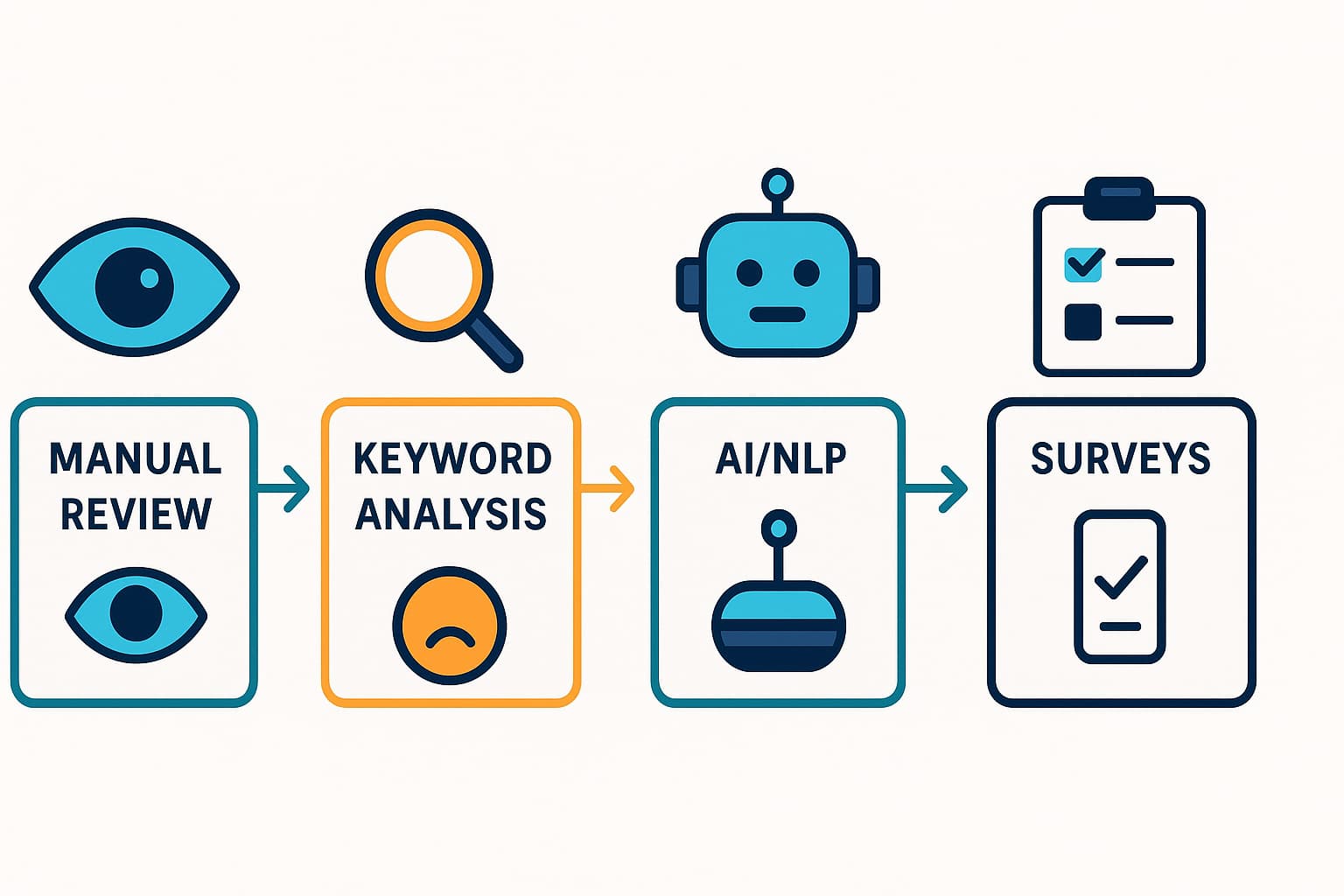What Is Customer Sentiment and How Do You Measure It?
by

- Understanding How Customers Really Feel
- What Is Customer Sentiment?
- Why Customer Sentiment Matters
- Customer Sentiment vs. Customer Feedback
- How to Measure Customer Sentiment
- Turning Sentiment Into Action
- Common Mistakes to Avoid
- Tools That Help You Track and Measure Sentiment
- Building a Culture of Empathy and Feedback
- See How Pulse Supports Smarter Sentiment Tracking
- Key Takeaways
- FAQs
That story is called customer sentiment. It’s the heartbeat of your brand’s relationship with its audience. It reveals what people feel, not just what they say. When you understand that emotional current, you can predict loyalty, prevent churn, and turn feedback into a meaningful connection.
In this article, we’ll explore what customer sentiment really means, how to measure it with confidence, and why understanding emotion is key to long-term growth. Think of it as a guide to listening more closely, so your business doesn’t just respond, it truly connects.
Understanding How Customers Really Feel
Every business wants to know what customers say, but the real advantage comes from understanding how they feel. That emotional layer beneath feedback is called customer sentiment, and it can reveal more about loyalty, retention, and growth than any survey score ever could.
Customer sentiment refers to the emotions and attitudes people express toward your brand, product, or service. It shows up in social media posts, support emails, online reviews, and even how customers describe you to peers. The tone, not just the text, carries meaning. When measured correctly, it becomes a powerful indicator of how customers perceive your business.
According to research by PwC, 73% of customers say that their experience and how a brand makes them feel influence their loyalty more than price or product features. Understanding those emotional cues helps businesses act quickly, build trust, and create a more human connection with customers.
This article explores what customer sentiment is, why it matters, how to measure it effectively, and how tools like Pulse CRM can support businesses in turning raw feedback into actionable insights.

What Is Customer Sentiment?
Customer sentiment is the emotional tone customers use when discussing your brand, whether positive, negative, or neutral. It goes beyond star ratings or satisfaction surveys to capture how customers truly feel.
These emotions typically fall into three categories:
- Positive sentiment: satisfied, loyal, or enthusiastic customers.
- Negative sentiment: customers who are frustrated or disappointed.
- Neutral sentiment: indifferent or factual responses.
For example:
- “The setup was so easy, I was amazed!” → Positive
- “Support took days to reply.” → Negative
- “The software works as expected.” → Neutral
While customer satisfaction measures whether expectations were met, customer sentiment reveals how customers feel about those experiences. That distinction matters because emotion drives decision-making. A Harvard Business Review study found that emotionally engaged customers are more than twice as valuable as highly satisfied ones in terms of lifetime value.
Understanding those emotional signals allows marketing, sales, and support teams to move from reactive problem-solving to proactive relationship-building.

Why Customer Sentiment Matters
Customer sentiment analysis provides a window into your audience’s emotions, which influence revenue, loyalty, and brand reputation.
1. Predicting Loyalty and Retention
Customer sentiment acts as an early warning system. By identifying frustration or confusion early, businesses can intervene before customers churn. Gartner research shows that companies using advanced sentiment analysis see a 20% increase in customer retention on average.
It’s not about chasing happiness scores. It’s about understanding the emotional triggers behind them and acting fast. A timely response to a negative comment can transform a critic into a promoter.
2. Shaping Brand Reputation
In the digital age, sentiment travels fast. According to BrightLocal, 91% of consumers read online reviews before buying, and 84% trust those reviews as much as personal recommendations. One emotionally charged review can shape the perception of hundreds of potential buyers.
Tracking sentiment helps businesses stay ahead of reputation shifts. Positive sentiment signals opportunities for advocacy. Negative trends reveal areas to improve before they go public.
3. Guiding Marketing Strategy
Sentiment insights give marketers a real-world compass for messaging. If customers consistently describe your service as “easy” or “fast,” those words should appear in campaigns. Conversely, if feedback includes “confusing” or “expensive,” marketing can adjust tone and focus.
A McKinsey report found that brands using customer emotion data in their marketing saw campaign ROI increase by up to 40%. It’s not guesswork; it’s emotion-led optimization.
4. Improving Customer Support
Sentiment doesn’t just help marketers; it helps service teams too. When agents understand the emotional tone behind messages, they can tailor responses. Empathetic communication can defuse tension, build rapport, and resolve issues faster.
For instance, many businesses now integrate AI tools with their CRM systems using solutions like Zapier or custom API connections. This allows them to automatically flag negative sentiment in emails or chats and route those messages for faster follow-up. With automation handling detection and tagging, support managers can prioritize urgent cases or respond personally, improving customer satisfaction and reducing response times.
Let Us Help You Get Started!
Pulse CRM delivers more than software. We’re your partner in success.
We fully set up your CRM, including importing your data, configuring sales and marketing automations, designing branded email templates, writing engaging email copy, setting up sales pipelines, and much more.
Customer Sentiment vs. Customer Feedback
Customer feedback and sentiment are related, but not identical. Feedback provides data points, while sentiment offers emotional context.
- Feedback: Tells you what customers say.
- Sentiment: Reveals how they feel about it.
Analyzing both together provides a complete view of the customer experience. For example, survey data may show that customers rate your service 8 out of 10. But if open-ended comments repeatedly mention feeling “ignored” or “overwhelmed,” the real issue isn’t satisfaction; it’s emotional fatigue.
According to a Forrester report, businesses that analyze both qualitative sentiment and quantitative data outperform peers in customer satisfaction by 23%. Combining these insights uncovers blind spots that traditional metrics can miss.

How to Measure Customer Sentiment
Modern sentiment analysis combines human interpretation and AI-driven technology. Here are four primary methods.
1. Manual Review
For smaller businesses, start simple. Read customer reviews, emails, and messages, and categorize them by emotional tone. While labor-intensive, this process builds intuition about customer behavior and language patterns.
2. Keyword-Based Analysis
Keyword scanning tools flag emotional words like “amazing,” “frustrating,” or “unhelpful.” Though basic, this approach can quickly highlight trends. Over time, these insights guide product and support improvements.
3. AI and Natural Language Processing (NLP)
AI tools analyze text at scale, detecting tone and categorizing sentiment automatically. They can process thousands of reviews or chat transcripts in seconds. Platforms such as Lexalytics use NLP to score sentiment and identify emotions like joy, anger, or disappointment.
While Pulse CRM doesn’t include built-in AI yet, it can integrate with AI-based analytics tools through Zapier or API connections. This allows teams to automatically import sentiment insights from platforms like MonkeyLearn or Lexalytics and visualize them alongside customer interactions within Pulse.
4. Surveys and Net Promoter Score (NPS)
Pair open-ended survey questions with structured metrics like NPS or CSAT (Customer Satisfaction Score). Ask, “What made you rate us this way?” The words people choose often matter more than the numbers they select.
Harvard Business Review research found that open-ended feedback increased predictive accuracy for customer retention by nearly 30%. Emotional expression is a stronger predictor than star ratings alone.

Turning Sentiment Into Action
Sentiment analysis matters only when insights lead to meaningful action. Here’s how to make that leap.
1. Segment and Prioritize
Group customers based on sentiment trends. Negative feedback from long-term clients deserves a faster, more personal response than isolated one-off complaints. Prioritization ensures limited resources deliver maximum impact.
2. Identify Emotional Triggers
Look for patterns. Do spikes in frustration coincide with product launches or billing cycles? Identifying emotional triggers reveals operational gaps. According to independent research published by the Customer Contact Week Digital (CCW) community, businesses that act on emotion-based feedback can reduce customer churn by up to 25%. This highlights the power of emotional insight in driving retention and operational improvement.
3. Close the Loop
Follow up personally with customers who express strong negative emotions. Even a short, empathetic email can turn sentiment around. Research from the University of Texas shows that acknowledgment alone, even without an immediate solution, can reduce customer anger by 40%.
4. Integrate Sentiment Into Strategy
Feed sentiment insights into your broader business strategy. Marketing can adapt tone, product teams can address recurring issues, and support can tailor training. Pulse CRM enables teams to centralize feedback and visualize trends, ensuring insights reach every department that needs them.
Common Mistakes to Avoid
- Treating Sentiment as Static: Emotions evolve. Track over time, not just once.
- Ignoring Neutral Feedback: Neutral comments often reveal friction points waiting to be improved.
- Focusing Only on Negatives: Celebrate what customers love. Positive emotion is a growth signal.
- Measuring Without Acting: Data means little if it doesn’t drive change.
Each mistake reduces the potential of sentiment analysis to drive long-term value. Businesses that treat emotional data as an ongoing conversation, not a one-time report, consistently outperform competitors in retention and satisfaction.
Tools That Help You Track and Measure Sentiment
- Pulse CRM: Centralizes customer feedback collected from forms and integrates with other tools to help teams track and organize sentiment data in one place.
- Google Reviews and Social Listening Tools: Tools like Brand24, Mention, and Hootsuite analyze social media conversations to identify emotional patterns and overall customer perception.
- Survey Tools: Pulse CRM, Typeform, Qualtrics, and SurveyMonkey allow teams to collect open-ended responses that reveal customer emotions and motivations behind feedback. With Pulse CRM’s built-in form builder, teams can easily create custom feedback request forms, helping streamline data collection and improve visibility into how customers feel at every touchpoint.
The best approach is often a hybrid one. Pair human empathy with technology. Automated systems can identify tone and urgency, while people interpret nuance and decide how to respond in meaningful ways.
Let Us Help You Get Started!
Pulse CRM delivers more than software. We’re your partner in success.
We fully set up your CRM, including importing your data, configuring sales and marketing automations, designing branded email templates, writing engaging email copy, setting up sales pipelines, and much more.
Building a Culture of Empathy and Feedback
At its core, sentiment analysis is about empathy. It’s a way to understand customers on a deeper level, not just what they do, but why they feel that way. Businesses that treat emotion as insight build stronger, longer-lasting relationships.
Consider a mid-sized service company that struggled with inconsistent customer reviews. Instead of pushing for more surveys, they began holding weekly “voice of the customer” sessions. Employees listened to recorded feedback and discussed how certain phrases, such as “felt rushed” or “felt appreciated,” connected to company actions. Over time, those discussions influenced policy changes, the tone of communication, and even how success was measured. Within three months, their overall customer sentiment score improved by 22%.
Why it matters: Empathy is not a soft skill; it’s a performance multiplier. According to Deloitte, organizations that lead with empathy outperform peers in revenue growth by 20%. When employees understand how customers feel, they make better decisions and create experiences that stick.
To build a culture of empathy and feedback, start with three practical steps:
- Make feedback visible. Share customer comments and sentiment reports across teams. Don’t let insights live in silos.
- Reward emotional intelligence. Recognize team members who turn difficult interactions into positive outcomes.
- Close the loop publicly. When you act on feedback, tell your customers. Transparency builds trust and encourages ongoing dialogue.
Pulse CRM makes this easier by collecting and organizing customer feedback from forms into a central dashboard. It helps teams see patterns in responses, connect those insights with customer records, and share takeaways across departments. That visibility empowers everyone to understand emotional trends earlier and respond with more empathy and precision.
When empathy becomes operationalized, it transforms culture. Teams stop reacting and start anticipating. Customers feel genuinely understood, and that emotional connection becomes the foundation of lasting growth.

See How Pulse Supports Smarter Sentiment Tracking
Pulse CRM helps you centralize customer interactions, monitor tone, and uncover emotional patterns across feedback channels, so your team can act faster and more effectively.
Key Takeaways
- Customer sentiment measures how customers feel, not just what they say.
- Tracking emotions helps predict loyalty, churn, and satisfaction.
- Pair AI-driven analysis with human understanding for the best insights.
- Use sentiment trends to guide marketing, support, and product strategy.
- Businesses that listen and act on emotion build stronger, more resilient customer relationships.
FAQs
It’s the emotional tone behind customer feedback —positive, negative, or neutral —that reveals how people feel about your brand. Understanding sentiment helps you see beyond what customers say to why they feel that way. For example, two customers might both rate your service a “7,” but one feels hopeful while the other feels disappointed. Recognizing that difference allows your team to tailor responses and strengthen relationships over time.
You can measure sentiment through manual review, keyword tracking, or AI integrations that interpret tone and emotion at scale. Even simple tools can highlight recurring themes in feedback. For instance, a local service company might notice repeated words like “slow” or “friendly” in reviews, signaling where to improve or where to double down. Pulse CRM can centralize these insights by syncing data from review platforms or surveys into one dashboard.
Because emotions drive purchasing decisions and long-term loyalty more than logic alone. Customers who feel heard and understood are more likely to return, refer others, and forgive small mistakes. For example, a company that promptly responds with empathy after a negative review can often turn that experience into advocacy. Measuring sentiment helps you catch those moments and build lasting trust.
Platforms like Pulse CRM and Brand24 make it easier to collect, analyze, and act on sentiment data. For smaller businesses, even using free survey tools or Google Alerts can help identify emotional trends in feedback. What matters most isn’t the tool itself, but how consistently you listen and respond. The goal is to turn emotional insights into better communication and customer care.



